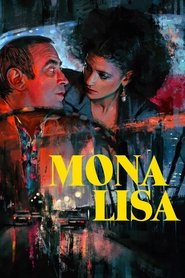A distant, British, relation of Taxi Driver, perhaps? There's just a hint of magical realism in Mona Lisa — or at least conventional stage magic. The rabbit is of course a staple of magic shows, as are variations on a 'disappearing' girl. But none of that can explain the symbolic presence of the white horse, by far the best touch in the film and one that demonstrates Neil Jordan's "skill at fusing pulp and poetry." Perhaps some element of fantasy logic is required to accept George and Simone mixed-race pseudo-relationship existing in mid-1980s Britain.
[Michael Caine] signed on to play the clammy-faced kingpin Mortwell[.] This is a small role (six short scenes), and the movie acknowledges as much by showing Mortwell emerging from a function in the Cameo Room at a plush hotel. Perhaps he was hobnobbing in there with The Third Man’s Harry Lime, another villain whose poisonous pervasiveness is out of all proportion to his screen time.[…]
Everything in the film, which itself contains a love triangle, comes in threes. George tries to restore his place in the three-member family he left behind […]. A selection of thugs forms a sordid triumvirate: the nameless street-corner pimp, [the] sleekly menacing Anderson, [and] Mortwell, the unholy father, at the top. Violence, too, obeys the rule of three. George enters Simone’s apartment block (Trinity Court, no less) on three occasions, with the razor-wielding Anderson bursting from the shadows during the final one. When George walks into the Royal Albion hotel in Brighton for the third time, we are primed to expect trouble. Sure enough, Mortwell is lying in wait, the white rabbit in his lap carrying the faintest echo of Blofeld’s cat.
— Ryan Gilbey (Criterion)
I never watch the films I’ve made after they open. This one [I] had to watch across a gap of ten years. I could see all the above influences in the story, all the generic traces that would shape a film like this. But most of all I could see a film of a kind there is no generic name for, but for which there should be. A film that is indistinguishable from its central performance; the moods, light, perspectives, emotions of which are defined by the central character […].
— Neil Jordan (Director)
Mona Lisa throws subtlety to the wind as soon as Simone’s obsession with finding and saving a friend and fellow sex worker, […] becomes the driving force of the narrative. Suddenly the film is dedicated above all else to a clearly defined action and it transforms into a second-rate Taxi Driver. [By] the time of the last-act twist, which uses queerness primarily in the service of a narrative rug pull, Mona Lisa has fully transformed from an intimate study of love amid perilous conditions to a more generic thriller that reinforces traditional gender roles.
— Derek Smith (Slant Magazine)
It's interesting to note that Jordan filmed a scene in which George and Simone spent the night together, but cut it from the final release because it compromised the essence of both the characters and their relationship.
— James Berardinelli (Reelviews)
Synopsis: George is a small-time crook just out of prison who discovers his tough-guy image is out of date. Reduced to working as a minder/driver for high class call girl Simone, he has to agree when she asks him to find a young colleague from her King's Cross days. That's when George's troubles just start.

